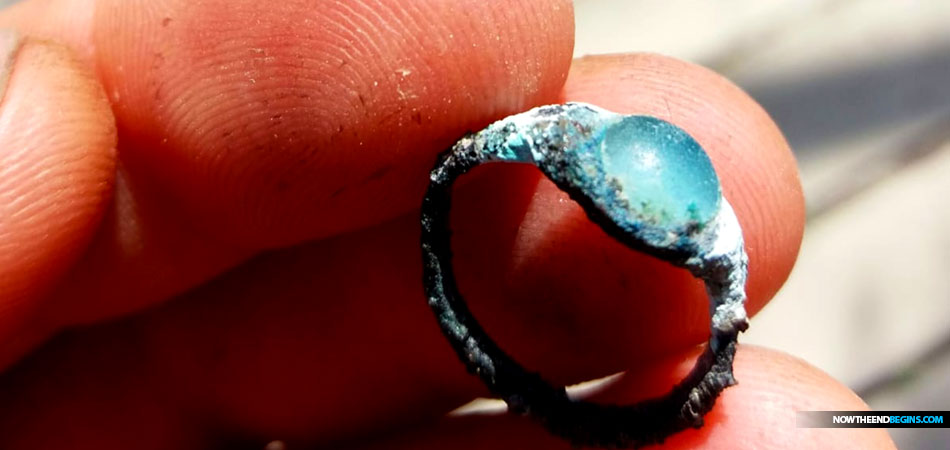
Some 2,000 years ago, a Jewish penitent misplaced a bronze ring during his climb of a 600-meter-long (about 2,000 feet) pilgrims’ thoroughfare leading to the Temple Mount. While the recently recovered ring is today heavily corroded, its central blue semi-precious stone still sparkles.
Fascinating archaeological discoveries from bible times are happening so rapidly now, we have devoted an
entire section of our site to bringing them to your attention. We highly recommend you check it out. The Bible in both Testaments is a true and trustworthy Book, and I love it when God lets us uncover more evidence showing we can trust His Book wholeheartedly.
"For the prophecy came not in old time by the will of man: but holy men of God spake as they were moved by the Holy Ghost." 2 Peter 1:21 (KJV)
What a contrast this is to books like the Book of Mormon where nothing from it has ever been discovered, and
no location it uniquely mentions ever found. That's because the Bible from Genesis to Revelation was written by the Holy Spirit, and the Book of Mormon by the demon Moroni.
One of the great things about all these discoveries is that archaeology demonstrates for us proof-positive the unbreakable tie between Jerusalem, the nation of Israel and the Jewish people.
2,000-year-old ring discovered in Jerusalem’s City of David
FROM TIMES OF ISRAEL: The ring was recently discovered at the
City of David’s Sifting Project in Emek HaTsurim, in a bucket of dirt excavated from a structure on the side of the broad 7.5-meter (24-feet) -wide road that is thought to have housed a ritual bath, or mikveh. According to City of David archaeologists, the worshiper likely lost the ring when fresh from ritual purification prior to his ascent to the Temple Mount.
For the past seven years at the
City of David National Park in Jerusalem, archaeologists have been excavating a now-subterranean stairway that once served as a main artery to the Temple Mount, beginning at the intersection of the Kidron and Ben Hinnom Valleys.
“Every step on this street brought the pilgrims closer to the Temple,” said City of David archaeologist Nahshon Szanton, in a recent video tour of the site. “Imagine to yourselves the joy, the songs, the prayers, the spiritual journey that these people experience when they know they are just meters away from reaching the gates of the Temple,” he added, while climbing the monumental staircase.
The pilgrims’ road, which ascends from the Pool of Siloam to the Jewish Temple, dates to no earlier than 30-31 CE, during the time of the notorious Roman governor Pontius Pilate. In the short video, Szanton emphasized that this was the period when Jesus was sentenced to death.
“It’s incredible to think that this beautiful ring sat at the bottom of a mikveh on the ancient Pilgrimage Road for 2,000 years,
until it was uncovered by archaeologists in the City of David. It is yet another piece in the puzzle that is ancient Jerusalem,” said Doron Spielman, vice president of the City of David Foundation, an entity which oversees the national park.
source
According to the City of David, the Herodian road was lined with shops and businesses to serve the thousands of pilgrims to Jerusalem on the major holidays.
The broad road is a monumental achievement: Szanton estimates that some 10 tons of quarried rock was used in its construction. The road was built above a complex drainage system, which rebels hid in 40 years after the Pilgrims’ Path’s construction as the Second Temple was destroyed by the Romans in 70 CE.
READ MORE
No comments:
Post a Comment